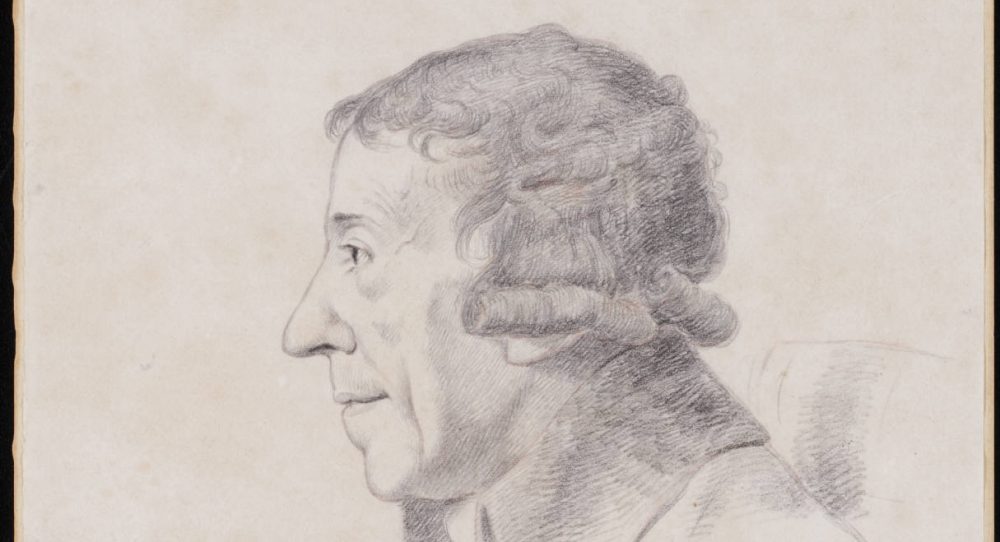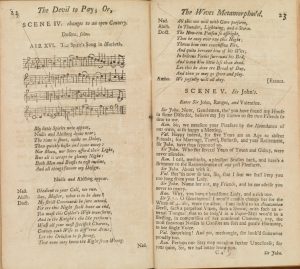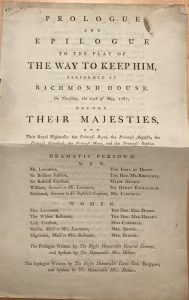18. Strawberry Hill Theatricals
By Judith Hawley, Royal Holloway, University of London
Horace Walpole maintained a lifelong interest in the theatre and is associated with leading theatrical personalities such as Kitty Clive and David Garrick. He also wrote for and about the stage. Best known in this connection is his tragedy, The Mysterious Mother (written 1768, soon to be performed as a staged reading https://walpole.library.yale.edu/event/staged-reading-horace-walpoles-play-mysterious-mother-1768).
This notorious play whose scandalous subject matter made it unperformable in his lifetime has perhaps caused his other contributions to theatrical culture to be overlooked. Not only did he write an afterpiece, Nature Will Prevail (1778) that was frequently performed in the eighteenth century, he contributed various prologues and epilogues for performances by friends by theatrical friends. Moreover, he was a serious critic of the state of the contemporary stage, writing a stinging Letter to David Garrick, Esq; On Opening the Theatre. In which, with great Freedom, he is told how he ought to behave (London: I. Pottinger, 1769) and the more measured Thoughts On Tragedy In Three Letters To Robert Jephson, Esq. and Thoughts on Comedy (1775, 1776) both published in The Works of Horatio Walpole, Earl of Orford (London: G.G. and J. Robinson, and J. Edwards, 1798). The aim of all these works is to reform the stage by encouraging original and experimental writing. One of his implications is that this kind of writing is more likely to come from amateurs of his class than professional playwrights who churn out formulaic works from commercial motives. He knew whereof he spoke. He amassed a library of eighty volumes of plays in two series. One series – ‘Theatre of the Reign of George the 3d’ (Hazen 1810) – comprising 58 volumes with an additional volume of prologues, epilogues and newspaper clippings, contains plays dated 1760-95. The other, known as ‘A collection of plays’ (Hazen 1818), is in 23 volumes and contains plays dated 1730-60. Each volume contained multiple works and his collection ran to over 700 plays. The volumes in Hazen 1818 each had a contents page written by Walpole and many bear his notes and markings in pen. The ‘Theatre of the Reign of George the 3d’ was more systematically annotated by Walpole with information such as the date of first performance and authorship; many were tagged with gossipy anecdotes (see Hazen, vol. II, pp. 98-143, 145-56).
One play in this vast collection stands out because it is annotated in a substantially different way. The sixth item in volume five of Hazen 1818 is The Devil to Pay; or, the Wives Metamorphosed (1731). It is heavily scored in pencil throughout. This three-act ballad opera by Charles Coffey (d. 1745) and John Mottley (1692-1750) was adapted from Thomas Jevon’s Devil of a Wife (1686). The plot contains Shakespearean elements in the form of the taming of a shrewish wife and the humiliation of a puritanical character who tries to ban Christmas revels. The termagant, Lady Loverule, is encouraged by her hypocritical non-conformist parson, Ananias, to persecute her pleasure-loving husband and servants. At the same time, a drunken cobbler, Jobson, abuses his lovely wife, Nell (played, when it opened at Drury Lane in 1731, by Miss Raftor, i.e. Kitty Clive). By means of magic, the two wives are swapped with the result that Jobson whips Lady Loverule into submission. Sir John Loverule, delighted that his wife has been tamed, pays Jobson to take back Nell on condition that he ceases beating her. This nasty comedy was further adapted by Theophilus Cibber who reduced it to one act in 1748 by stripping out the non-conformist sub-plot and various minor characters. Hazen suggests that the pencil markings make the text correspond with the one-act version: ‘the text has been marked in pencil for extensive cutting, as shortened by Theophilus Cibber.’ (Hazen, II, p. 147) We can tell that Walpole knew this play as he alluded to it several times in his correspondence (Correspondence, 12: 150; 13: 167; 18: 51). But did he mark these cuts, and if so, why did he depart so much from his usual practice?
A further mystery resides in the fact that the cuts do not entirely coincide with Cibber’s one-act version. For example, pages 22-34 are crossed out thus omitting all of act one scenes four and five and act two scene one. Cibber’s version retains I.iv in which the doctor conjures up his spirits to effect the wife-swap, but cuts the other two scenes in the first of which Lord Loverule complains about his wife to some old friends and in the second, the servants torment Ananias.
A volume which fairly recently found its way back to Strawberry Hill sheds some light on this mystery. An octavo volume with half calf binding and worn marbled paper boards lettered ‘PLAYS’ on its spine reveals who annotated Walpole’s copy of The Devil to Pay and why. The volume is listed as ‘Collection of seven play scripts’ and described in the exhibition catalogue, Anne Damer: Sculpture and Society, ed. Michael Snodin (Twickenham: Strawberry Hill Trust, 2014), p. 18. (I am grateful to Michael Snodin for drawing it to my attention and to Nick Dolan for allowing me to view and photograph it.) It collects together the prompt books Anne Seymour Damer used in her private theatricals. A prompt book is the copy of the script marked up for the use of the prompter during the performance; it includes cuts to the text and details such as cues, entrances and exits as the prompter had duties which overlapped with those of the modern stage manager. Private theatricals – amateur performances staged in private houses for an invited audience – were extremely popular in the second half of the eighteenth century, especially in Walpole’s circle. His niece, the sculptress Anne Damer was a keen participant in the theatricals staged at Richmond House in 1787 and 1788. The LWL holds copies of the playbills, prologues and epilogues for these performances.
After she inherited responsibility for Strawberry Hill House, she continued to stage performances there. Two performances are known from playbills held at LWL: in 1800 Damer and her friends staged The Old Maid (1761) by Arthur Murphy and Henry Fielding’s The Intriguing Chambermaid (1733). The following year, they performed Fashionable Friends, the satirical comedy written by her dear friend, Mary Berry and Lovers’ Quarrels. Damer’s prompt book does not seem to tally with the repertoire as recorded on these playbills. It comprises an unmarked copy of Colley Cibber’s Richard III; two copies of Susannah Centlivre’s The Wonder: a Woman Keeps a Secret (1714), one marked up for performance; Sir John Vanbrugh’s The Mistake (1705), marked up for performance; Henry Fielding’s The Intriguing Chamber Maid (1733) (also prepared for performance) and two copies of The Devil to Pay in the one-act version, both marked up but with some differences between them. There are recorded performances of some of the texts: The Wonder was performed at Richmond House in 1788; The Intriguing Chamber Maid was on the bill with The Old Maid at Strawberry Hill in 1800 (though there is no prompt copy of the latter in this volume). Others are puzzling. There is no record of a performance of Richard III associated with Damer and the text is not annotated. It doesn’t seem as if Damer produced The Mistake but actually Lover’s Quarrels is based on Vanbrugh’s five-act comedy: Thomas King (1730-1805) reduced it to the two-act farce Like Master Like Man in 1766 and it was later performed under the title Lover’s Quarrels: or Like Master Like Man. Damer’s cuts to The Mistake, which include deletions in pen and the cancellation of scenes by sticking pages together with sealing wax, are thus comparable to the pencil markings on Walpole’s copy of The Devil to Pay.So, the Strawberry Hill prompt book provides evidence that Damer edited longer versions of a play to create a performance script. It is possible that she scanned the shelves of Walpole’s library looking for a play that might work for her troupe. Perhaps she tried to adapt the three-act Devil to Pay herself, then decided to work with the one-act version. Perhaps they didn’t have enough copies of the script so had to mark up this one. Further mysteries remain. The first is the date of performance: in the absence of a playbill, we cannot date this performance with certainty, but there is a Dramatis Personae which provides some clues.
Dramatis PersonaeSir John Loverule = Mr Mercer
[The Music Master in Fashionable Friends and Don Carlos in Lover’s Quarrels (1801)]
Jobson = Mr North
Conjuror [i.e. Doctor] = Earl of Mt Edgcumbe
[Clerimont in The Old Maid and Valentine in Intriguing Chambermaid (1800); Sir Dudley Dorimont in Fashionable Friends and Sancho in Lover’s Quarrels (1801)]
Butler = Mr Campbell
[Slap and Security in Intriguing Chambermaid (1800); John in Fashionable Friends and Lopez in Lover’s Quarrels (1801)]
Cook = Mr Burn
[Mr Harlow in The Old Maid and Goodall in Intriguing Chambermaid (1800); Lapierre in Fashionable Friends (1801)]
Coachman = Mr Berry
[Captain Cape in The Old Maid and Oldcastle in Intriguing Chambermaid (1800); Sir Valentine Vapour in Fashionable Friends (1801)]
Lady Loverule = Mrs Burn
[Mrs Harlow in The Old Maid and Mrs Highman in Intriguing Chambermaid (1800); Mrs Racket in Fashionable Friends (1801)]
Nell = Miss A Berry
[Trifle in The Old Maid and Charlotte in Intriguing Chambermaid (1800); Miss Racket in Fashionable Friends (1801)]
Lucy = Mrs Damer
[Lettice in Intriguing Chambermaid and the Epilogue (1800); Lady Selina Vapour in Fashionable Friends and Jacintha in Lover’s Quarrels (1801)]
Lettice = Lady Eliz. Cole
[Trimming in Fashionable Friends (1801)]
I suggest The Devil to Pay was staged in 1798-99, after she had taken charge of the house and before the performances detailed on the surviving playbills. Why not after then? In 1802, Damer and some of the company, perhaps buoyed by their success at Strawberry, engaged in two ambitious schemes which went disastrously wrong. Damer, Mr Campbell and Richard Edgcumbe, 2nd Earl of Mount Edgcumbe and many other friends who had engaged in private theatricals for years, formed the Pic Nic Society, a subscription theatre-and-supper club which briefly occupied the Tottenham Street Theatre in London. The managers of the patent theatres saw it as a direct threat to their revenues so mounted a press campaign that brought an end to the Pic Nic within a year. The furore also affected the other ambitious project that came from ‘the Theatre Strawberry’: Mary Berry’s Fashionable Friends was staged at Drury Lane in May 1802 but, because ‘the pit-filling public’ believed it to be ‘the production of some one of a certain Pic-nic Club then existing … they indignantly determined to stifle in it birth, and come to the first night determined to damn, without hearing it.’ (Preface to Fashionable Friends in Mary Berry, A comparative view of social life in England and France … To which are now first added, the lives of the Marquise Du Deffand and of Rachel lady Russell–Fashionable friends, a comedy, &c., by the same author, a new ed. (London: R. Bentley, 1844).)
Horace Walpole was intimately involved in theatrical culture as a fan and patron of actors, as a critic, playwright and collector. He eagerly transmitted gossip about both the professional stage and the private theatricals staged by numerous members of his circle. His library and house then fostered the theatrical activities of his beloved Damer and the Berrys. There is one final oddity about his copy of The Devil to Pay which demands explanation. There is a series of tiny deletions which is particularly intriguing. Among the revellers who celebrate Christmas in the home of Sir John Loverule is a character who does not appear in the Dramatis Personae: ‘the blind Fidler’. He appears in only one scene: act I, scene ii. The first reference to him occurs when the Butler wishes he were there so they could rejoice that the Lady has gone out (i.ii.5). Shortly after, he enters with Jobson and some neighbours and the Butler calls on ‘blind Will’ to strike up the music so they can sing a catch (I.ii.9-10). His only line is spoken when Lady Loverule breaks up the party and ‘Beats the Fiddle about the blind Man’s Head.’ (I.ii.15) The poor fellow exclaims ‘O Murder, Murder! I am a dark Man, which way shall I get hence? Oh Heav’n! she has broke my Fiddle, and undone me and my Wife and Children.’ Sir John pays him some compensation and sends him on his way.
He does not play a major role in the action, but the annotator pays a disproportionate amount of attention to him, striking out references to his blindness albeit very faintly on three of the four occasions on which it is mentioned.
These deletions are clearer in Damer’s prompt book, and particularly emphatic in the second copy (this copy includes the Dramatis Personae reproduced above so I think it is the actual performance text).

[The Devil to Pay, copy 2, p. 4 in Collection of Seven Play Scripts. Courtesy of Strawberry Hill Trust.]

[The Devil to Pay, copy 2, p. 5 in Collection of Seven Play Scripts. Courtesy of Strawberry Hill Trust.]

[The Devil to Pay, copy 2, p. 7, in Collection of Seven Play Scripts. Courtesy of Strawberry Hill Trust.]
I am grateful to the staff of the LWL and to Nick Dolan at Strawberry Hill who made this research possible. Images from Anne Damer’s prompt book are reproduced with permission of the Strawberry Hill Trust.







